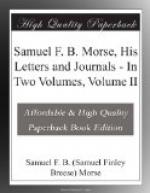And now my pleasant task is ended. After the lapse of so many years it has been possible for me to introduce much more evidence of a personal nature, to reveal the character of those with whom Morse had to contend, than would have been discreet or judicious during the lifetime of some of the actors in the drama. Many attempts have been made since the death of the inventor to minimize his fame, and to exalt others at his expense, but, while these attempts have seemed to triumph for a time, while they may have influenced a few minds and caused erroneous attributions to be made in some publications, their effect is ephemeral, for “Truth is mighty and will prevail,” and the more carefully and exhaustively this complicated subject is studied, the more apparent will it be that Morse never claimed more than was his due; that his upright, truthloving character, as revealed in his intimate correspondence and in the testimony of his contemporaries, forbade his ever stooping to deceit or wilful appropriation of the ideas of others.
A summary, in as few words as possible, of what Morse actually invented or discovered may be, at this point, appropriate.
In 1832, he conceived the idea of a true electric telegraph—a writing at a distance by means of the electromagnet. The use of the electro-magnet for this purpose was original with him; it was entirely different from any form of telegraph devised by others, and he was not aware, at the time, that any other person had even combined the words “electric” and “telegraph.”
The mechanism to produce the desired result, roughly drawn in the 1832 sketch-book, was elaborated and made by Morse alone, and produced actual results in 1835, 1836, and 1837. Still further perfected by him, with the legitimate assistance of others, it became the universal telegraph of to-day, holding its own and successfully contending with all other plans of telegraphs devised by others.
He devised and perfected the dot-and-dash alphabet.
In 1836, he discovered the principle of the relay.
In 1838, he received a French patent for a system of railway telegraph, which also embodies the principle of the police and fire-alarm telegraph. At the same time he suggested a practical form of military telegraph.
In 1842, he laid the first subaqueous cable.
In 1842, he discovered, with Dr. Fisher, the principle of duplex telegraphy, and he was also the first to experiment with wireless telegraphy.
In addition to his electrical inventions and discoveries he was the first to experiment with the Daguerreotype in America, and, with Professor Draper, was the first in the world to take portraits by this means, Daguerre himself not thinking it possible.
The verdict of the world, as pronounced at the time of his death, has been strengthened with the lapse of years. He was one of the first to be immortalized in the Hall of Fame. His name, like those of Volta, Galvani, Ampere, and others, has been incorporated into everyday speech, and is now used to symbolize the language of that simple but marvellous invention which brings the whole world into intimate touch.




